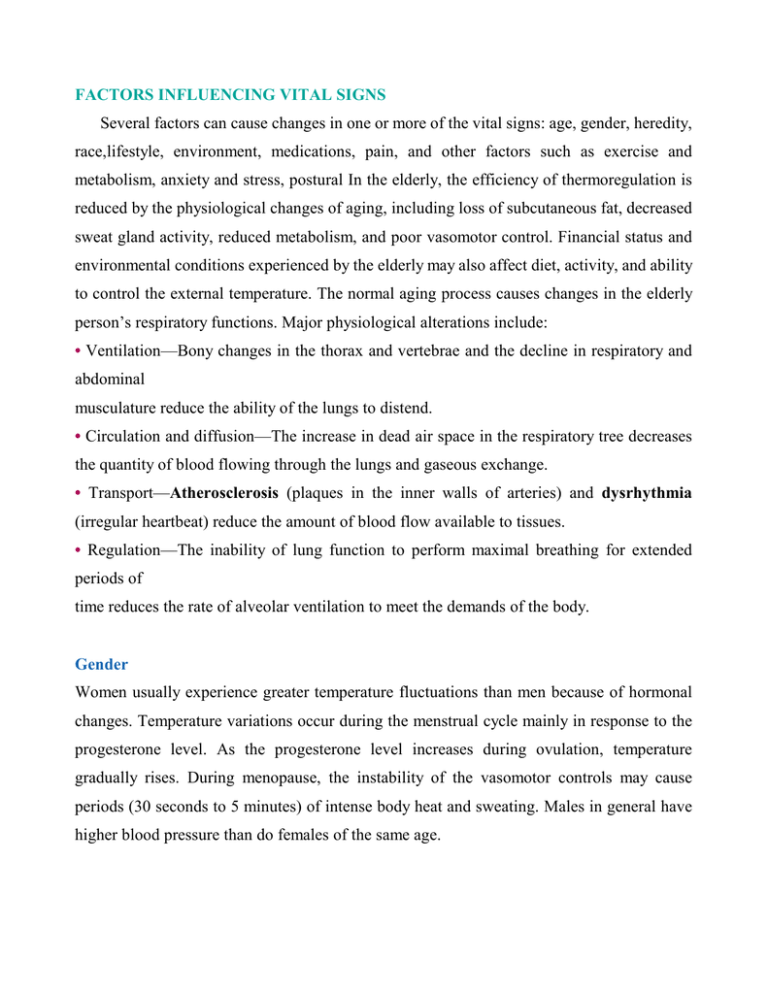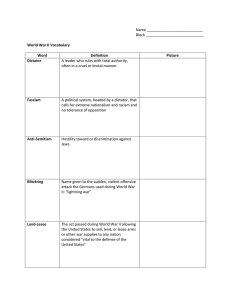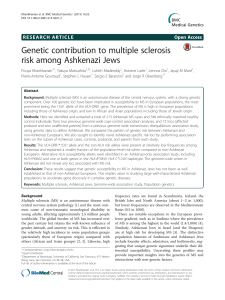FACTORS INFLUENCING VITAL SIGNS
advertisement

FACTORS INFLUENCING VITAL SIGNS Several factors can cause changes in one or more of the vital signs: age, gender, heredity, race,lifestyle, environment, medications, pain, and other factors such as exercise and metabolism, anxiety and stress, postural In the elderly, the efficiency of thermoregulation is reduced by the physiological changes of aging, including loss of subcutaneous fat, decreased sweat gland activity, reduced metabolism, and poor vasomotor control. Financial status and environmental conditions experienced by the elderly may also affect diet, activity, and ability to control the external temperature. The normal aging process causes changes in the elderly person’s respiratory functions. Major physiological alterations include: • Ventilation—Bony changes in the thorax and vertebrae and the decline in respiratory and abdominal musculature reduce the ability of the lungs to distend. • Circulation and diffusion—The increase in dead air space in the respiratory tree decreases the quantity of blood flowing through the lungs and gaseous exchange. • Transport—Atherosclerosis (plaques in the inner walls of arteries) and dysrhythmia (irregular heartbeat) reduce the amount of blood flow available to tissues. • Regulation—The inability of lung function to perform maximal breathing for extended periods of time reduces the rate of alveolar ventilation to meet the demands of the body. Gender Women usually experience greater temperature fluctuations than men because of hormonal changes. Temperature variations occur during the menstrual cycle mainly in response to the progesterone level. As the progesterone level increases during ovulation, temperature gradually rises. During menopause, the instability of the vasomotor controls may cause periods (30 seconds to 5 minutes) of intense body heat and sweating. Males in general have higher blood pressure than do females of the same age. Heredity Although many studies have been conducted to relate hereditary factors to specific cardiovascular disease occurrence, the results are often inconculsive regarding the influence of heredity versus environmental factors. For example, studies have been conducted to relate elevated blood cholesterol levels to a single gene. Giger and Davidhizar (1995) describe studies of Jews and nonJews and compare Ashkenazi Jews with Oriental Jews based on the theory that elevated blood cholesterol levels may be caused by a single gene. These studies indicate a higher occurrence of elevated blood cholesterol levels among Jews than among non-Jews and that Ashkenazi Jews may have a higher frequency of the gene than Oriental Jews. The conclusions of these studies indicate a need for further studies to be done to determine the frequency of heart disease among Jews, as well as the interplay between heredity and environment (Giger & Davidhizar, 1995). Race Some ethnic groups are more susceptible than others to homodynamic alterations. The incidence of hypertension is higher in African-Americans than in European Americans. For example, African-American men over the age of 35 have higher blood pressure than do European American men of the same age. Lifestyle Lifestyle factors, such as cigarette smoking, cause chronic changes in the lungs as manifested by impaired ventilation. Stimulants such as caffeinated beverages and tobacco elevate heart rate. The effects of exercise and stress are discussed below. Environment Environmental factors such as temperature and noise level can alter heart rate. Acid rain and industrialized areas are often associated with a high occurrence of respiratory conditions, such as infections and chronic lung diseases. Primary prevention is a major role of occupational (industrial) health nurses. A health screening examination relies heavily on vital sign measurements. Medications Some medications can directly or indirectly alter the pulse, respirations, or blood pressure. Digitalis preparations (cardiac glycosides) decrease the pulse rate. Narcotic analgesics (pain medications) can depress the rate and depth of respirations and lower the blood pressure.






